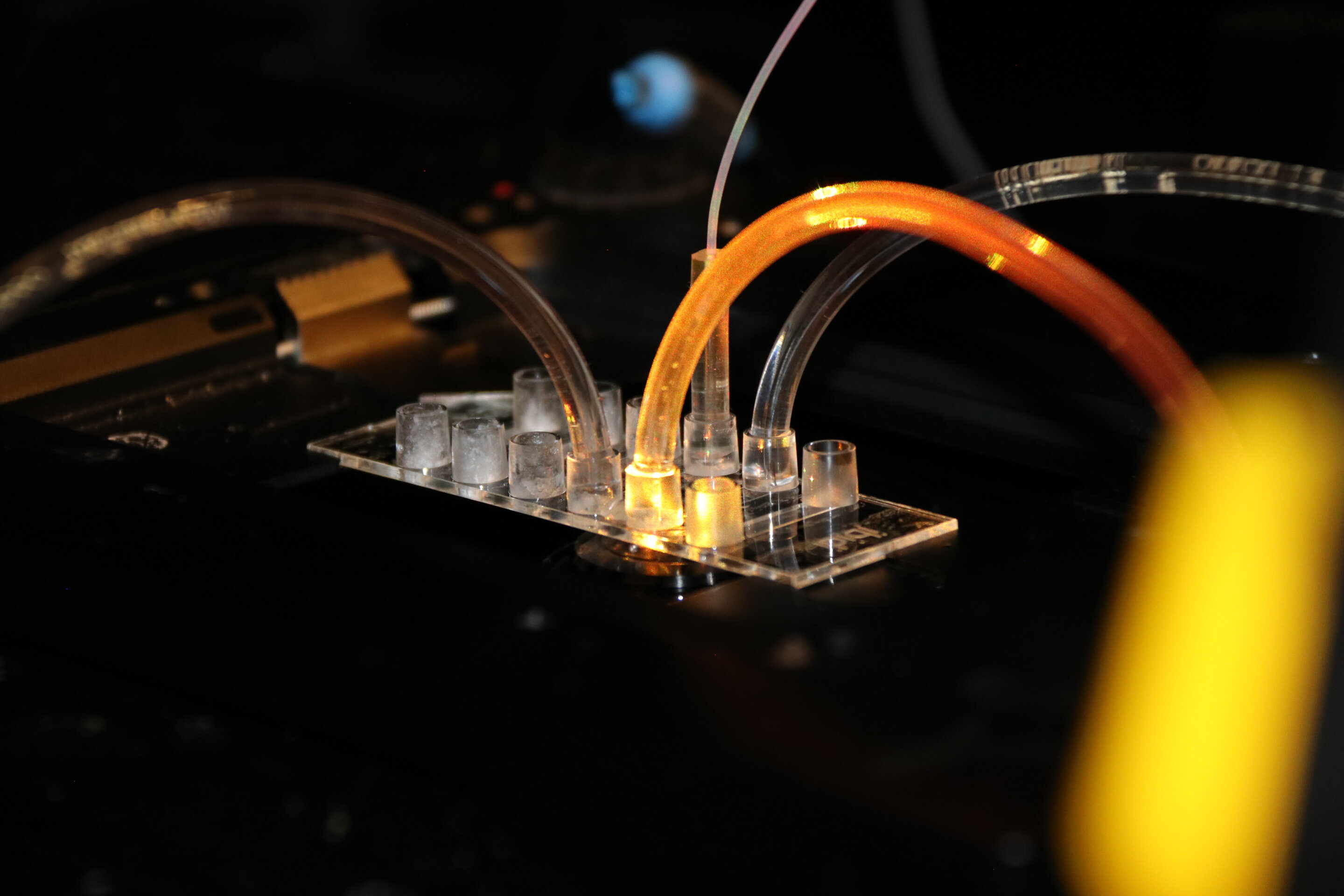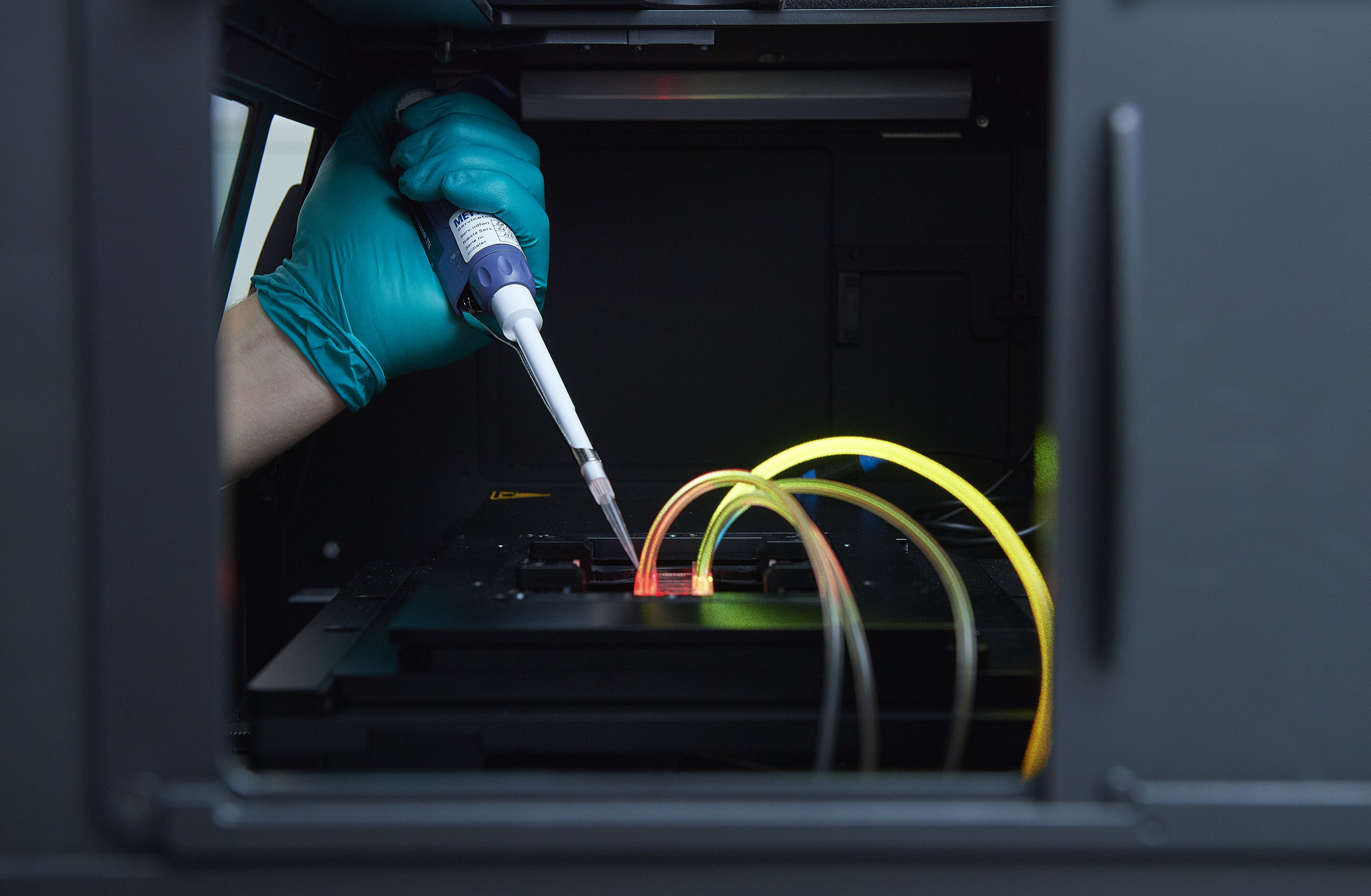博文
DNA纳米技术可以在降低成本的同时加快药物开发
 精选
精选
||
DNA纳米技术可以在降低成本的同时加快药物开发
诸平


据丹麦哥本哈根大学( University of Copenhagen)2022年4月4日提供的消息,一种新工具将疫苗和其他药品的开发速度加快100多万倍,同时将成本降至最低(A million times faster: DNA nanotechnology could speed up pharmaceutical development while minimizing costs)。
为了寻找药物制剂,如新疫苗,工业界将例行地扫描数千个相关的候选分子。一项新技术可以在纳米尺度上实现这一目标,最大限度地减少材料和能源的使用。相关研究结果于2022年4月4日已经在《自然化学》(Nature Chemistry)杂志网站发表——Mette Galsgaard Malle, Philipp M. G. Löffler, Søren S.-R. Bohr, Magnus Berg Sletfjerding, Nikolaj Alexander Risgaard, Simon Bo Jensen, Min Zhang, Per Hedegård, Stefan Vogel, Nikos S. Hatzakis. Single-particle combinatorial multiplexed liposome fusion mediated by DNA. Nature Chemistry, 2022. DOI: 10.1038/s41557-022-00912-5. Published: 04 April 2022. http://www.nature.com/articles/s41557-022-00912-5
参与此项研究的除了哥本哈根大学的研究人员之外,还有来自南丹麦大学(University of Southern Denmark)的研究人员。上述图1和图2都是哥本哈根大学的尼科斯·哈扎基斯提供的照片,显示一种新工具将疫苗和其他药品的开发速度加快100多万倍,同时将成本降至最低。这种方法使用类似肥皂的气泡作为纳米容器(nano-containers)。利用DNA纳米技术,多种成分可以在容器中混合。
在一个比针头还小的区域内,可以合成和分析超过40000个分子。这种方法是通过丹麦一项高度跨学科的研究成果开发出来的,有望大大降低制药公司(pharmaceutical companies)的材料、能源和经济成本。
“体积是如此之小,材料的使用可以与使用一升水和一千克材料相比,而不是所有海洋的全部体积的水来测试相当于珠穆朗玛峰的全部质量的材料。这是在精力、材料、人力和能源方面前所未有的节约,”该团队的负责人、哥本哈根大学化学系副教授尼科斯·哈扎基斯(Nikos Hatzakis)说。
上述论文的第一作者、博士生梅特·马莱(Mette G. Malle)说:“节省大量的时间、精力和人力对于任何药物的合成开发和评估都是至关重要的。”,梅特·马莱目前是美国哈佛大学(Harvard University)的博士后研究员。
结果只需7分钟(Results within just seven minutes)
这项工作是由哥本哈根大学的尼科斯·哈扎基斯小组和南丹麦大学的斯蒂芬·沃格尔(Stefan Vogel)副教授合作完成的。该项目得到了魏龙基金会卓越中心(Villum Foundation Center of Excellence)的资助。最终的解决方案被命名为“基于DNA介导融合的单粒子组合脂质纳米容器融合(single particle combinatorial lipidic nanocontainer fusion based on DNA mediated fusion)”,缩写为SPARCLD。
这一突破涉及到整合通常相距甚远的学科基本原理:包括合成生物化学(synthetic biochemistry)、纳米技术(nanotechnology)、DNA合成(DNA synthesis)、组合化学(combinational chemistry),甚至是人工智能(artificial intelligence简称AI)学科的机器学习(Machine Learning)。
尼科斯·哈扎基斯解释道:“我们的解决方案中没有一个元素是全新的,但它们从未如此无缝地结合在一起。”
该方法只需7分钟就能得出结果。
梅特·马莱说:“我们现在的情况非常接近现场直播。这意味着一个人可以不断地根据增加了显著附加价值的读数来调节设置。我们预计,这将成为希望实施解决方案的行业的一个关键因素。”
“不得不保守秘密('Had to keep things hush-hush')”
该项目中的研究人员来自不同的行业,但他们不知道哪些公司可能想要实施新的高通量方法(high-throughput method)。
“我们必须保密,因为我们不想冒险让别人在我们之前发布类似的内容。因此,我们不能与工业界或其他可能在各种应用中使用该方法的研究人员进行对话,”尼科斯·哈扎基斯说。
不过,他可以列举出一些可能的应用:
“一个安全的赌注是,参与合成长分子(如聚合物)的工业和学术团体可能是第一批采用这种方法的。与药物开发相关的配体合成也是如此。这种方法的特别之处在于它可以进一步集成,允许直接添加相关应用程序。”
这里的例子可以是重要的生物技术工具CRISPR的RNA串,也可以是筛选、检测和合成未来大流行疫苗的RNA的替代品。
“我们的设计允许将SPARCLD与蛋白质配体反应组合后的读数相结合,比如CRISPR中使用的那些。只是,我们还未能解决这个问题,因为我们想先公布我们的方法。”
上述介绍,仅供参考。欲了解更多信息,敬请注意浏览原文或者相关报道。
New method may improve prostate cancer and high cholesterol treatments
Combinatorial high-throughput methodologies are central for both screening and discovery in synthetic biochemistry and biomedical sciences. They are, however, often reliant on large-scale analyses and thus limited by a long running time and excessive materials cost. We here present a single-particle combinatorial multiplexed liposome fusion mediated by DNA for parallelized multistep and non-deterministic fusion of individual subattolitre nanocontainers. We observed directly the efficient (>93%) and leakage free stochastic fusion sequences for arrays of surface-tethered target liposomes with six freely diffusing populations of cargo liposomes, each functionalized with individual lipidated single-stranded DNA and fluorescently barcoded by a distinct ratio of chromophores. The stochastic fusion resulted in a distinct permutation of fusion sequences for each autonomous nanocontainer. Real-time total internal reflection imaging allowed the direct observation of >16,000 fusions and 566 distinct fusion sequences accurately classified using machine learning. The high-density arrays of surface-tethered target nanocontainers (~42,000 containers per mm2) offers entire combinatorial multiplex screens using only picograms of material.
https://m.sciencenet.cn/blog-212210-1332610.html
上一篇:我们能用石油残渣制造汽车吗?
下一篇:新算法可能是寻找引力波的量子飞跃